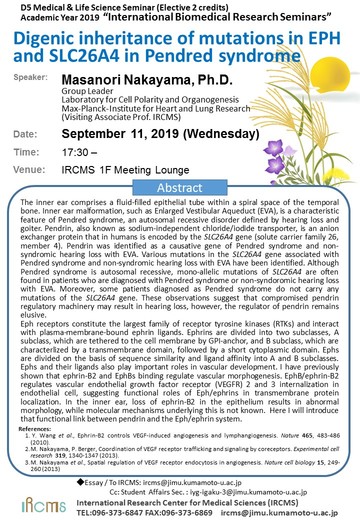- HOME
- News & Events
- [September 11] D5 Medical & Life Science Seminar - Dr. Masanori Nakayama
News & Events
[September 11] D5 Medical & Life Science Seminar - Dr. Masanori Nakayama
August 21 2019
The "D5 Medical & Life Science Seminar" course will be offered by International Research Center for Medical Sciences (IRCMS). It will run from April 2019 to March 2020, with lectures given by scientists who are affiliated with IRCMS or in collaboration with researchers at IRCMS. The lectures will be given once a month, in English, and by leading scientists in the relevant research field. Students will be taught: 1) how normal physiological functions are maintained in the human body; 2) how abnormalities in these systems (e.g., cancer) are studied using experimental models; 3) cutting-edge technologies (including single cell level imaging and omics analysis) used for mechanistic understanding of these abnormalities; 4) efforts and progresses in finding cure for human diseases associated with these abnormalities; and 5) importance of understanding disease mechanisms using cross-disciplinary approaches.
Date : September 11, 2019 (Wednesday)
Time : 17:30 -
Venue : IRCMS 1F Meeting Lounge
Speaker : Masanori Nakayama, Ph.D.
Group Leader
Laboratory for Cell Polarity and Organogenesis
Max-Planck-Institute for Heart and Lung Research
(Visiting Associate Prof. IRCMS)
Title : Digenic inheritance of mutations in EPH and SLC26A4 in Pendred syndrome
Abstract :
The inner ear comprises a fluid-filled epithelial tube within a spiral space of the temporal bone. Inner ear malformation, such as Enlarged Vestibular Aqueduct (EVA), is a characteristic feature of Pendred syndrome, an autosomal recessive disorder defined by hearing loss and goiter. Pendrin, also known as sodium-independent chloride/iodide transporter, is an anion exchanger protein that in humans is encoded by the SLC26A4 gene (solute carrier family 26, member 4). Pendrin was identified as a causative gene of Pendred syndrome and non-syndromic hearing loss with EVA. Various mutations in the SLC26A4 gene associated with Pendred syndrome and non-syndromic hearing loss with EVA have been identified. Although Pendred syndrome is autosomal recessive, mono-allelic mutations of SLC26A4 are often found in patients who are diagnosed with Pendred syndrome or non-syndoromic hearing loss with EVA. Moreover, some patients diagnosed as Pendred syndrome do not carry any mutations of the SLC26A4 gene. These observations suggest that compromised pendrin regulatory machinery may result in hearing loss, however, the regulator of pendrin remains elusive.
Eph receptors constitute the largest family of receptor tyrosine kinases (RTKs) and interact with plasma-membrane-bound ephrin ligands. Ephrins are divided into two subclasses, A subclass, which are tethered to the cell membrane by GPI-anchor, and B subclass, which are characterlized by a transmembrane domain, followed by a short cytoplasmic domain. Ephs are divided on the basis of sequence similarity and ligand affinity into A and B subclasses. Ephs and their ligands also play important roles in vascular development. I have previously shown that ephrin-B2 and EphBs binding regulate vascular morphogenesis. EphB/ephrin-B2 regulates vascular endothelial growth factor receptor (VEGFR) 2 and 3 internalization in endothelial cell, suggesting functional roles of Eph/ephrins in transmembrane protein localization. In the inner ear, loss of ephrin-B2 in the epithelium results in abnormal morphology, while molecular mechanisms underlying this is not known. Here I will introduce that functional link between pendrin and the Eph/ephrin system.
- Y. Wang et al., Ephrin-B2 controls VEGF-induced angiogenesis and lymphangiogenesis. Nature 465, 483-486 (2010).
- M. Nakayama, P. Berger, Coordination of VEGF receptor trafficking and signaling by coreceptors. Experimental cell research 319, 1340-1347 (2013).
- M. Nakayama et al., Spatial regulation of VEGF receptor endocytosis in angiogenesis. Nature cell biology 15, 249-260 (2013).

